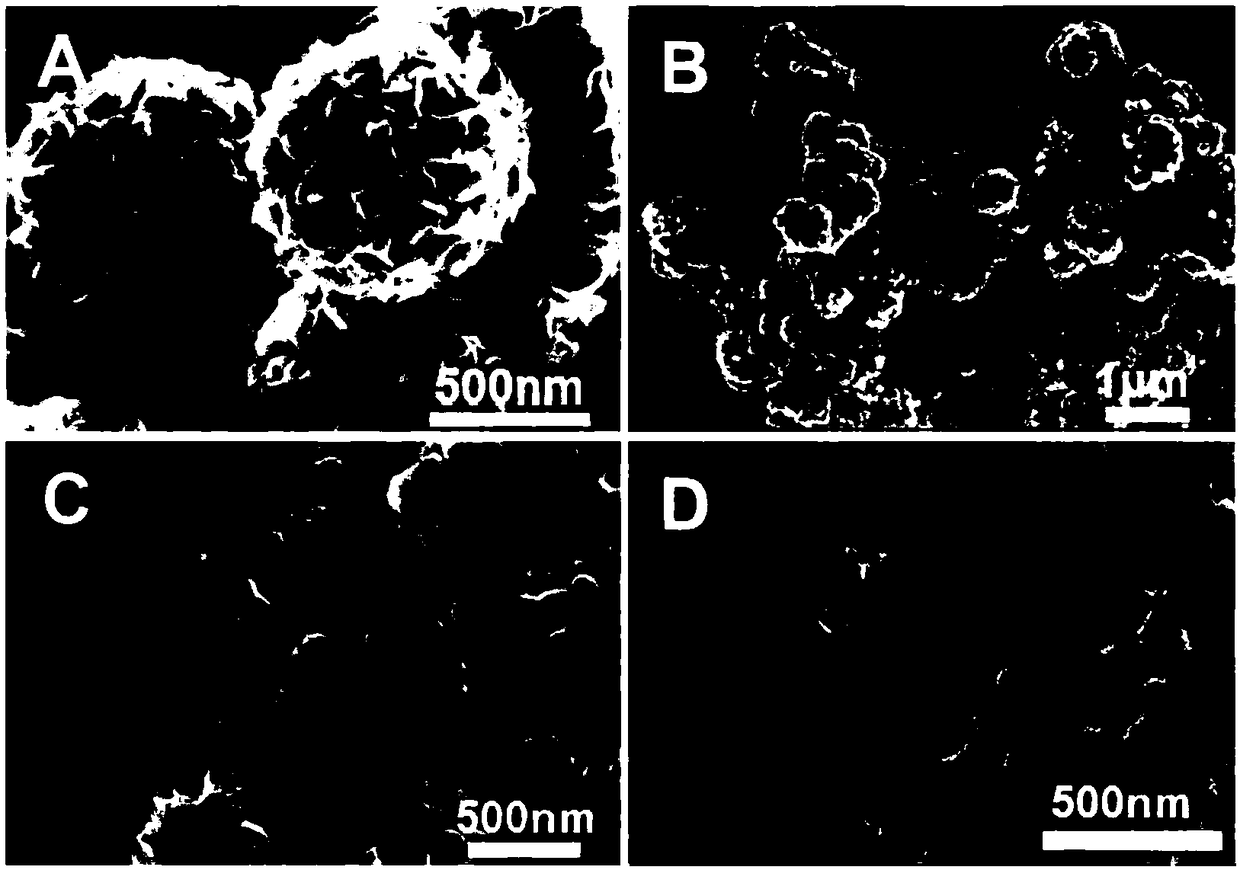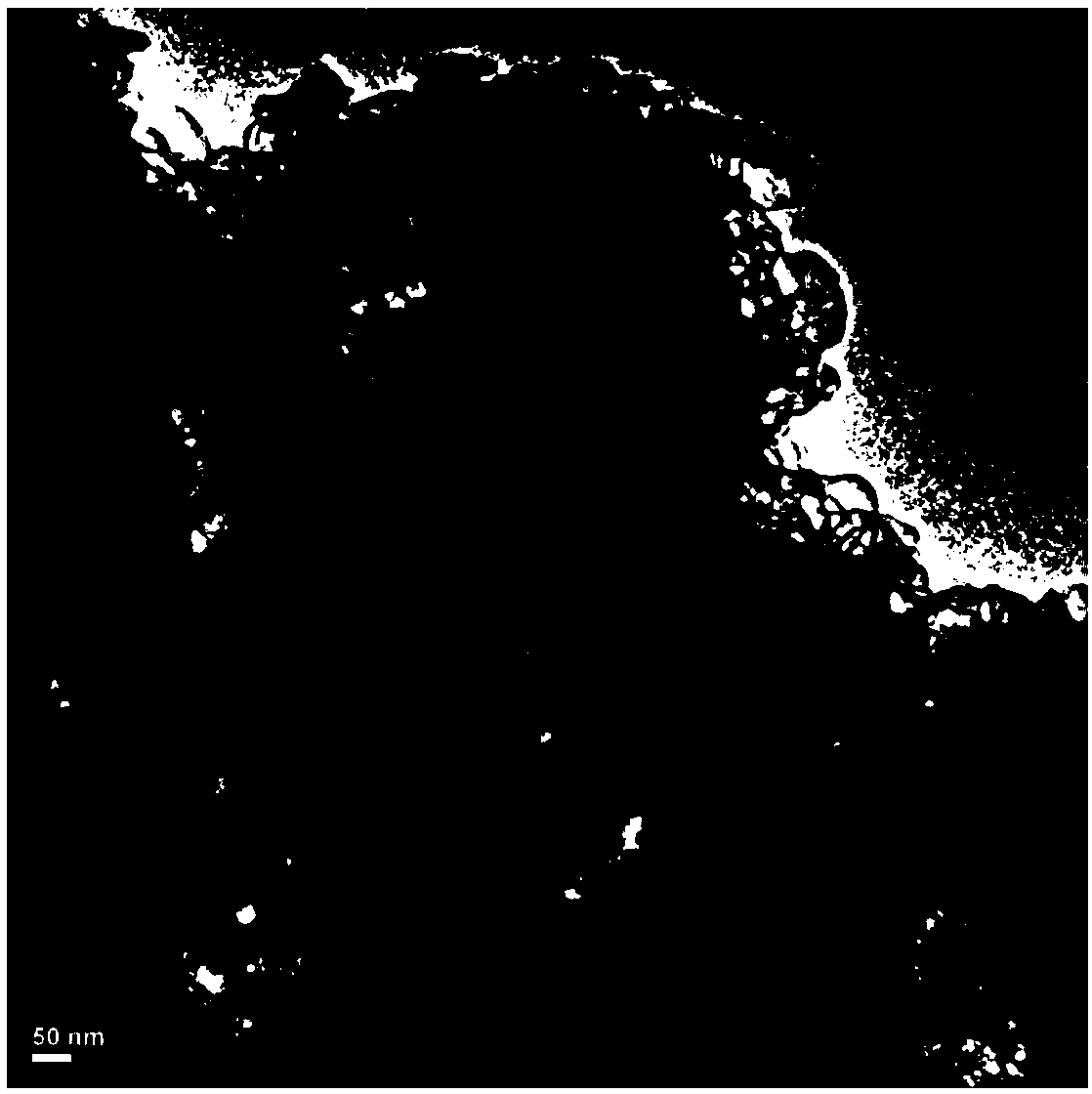Method for preparing molybdenum disulfide/stannic sulfide composite material of hollow structure
A molybdenum disulfide, composite material technology, applied in structural parts, secondary batteries, electrochemical generators, etc., can solve the problems of reduced active sites and specific surface area, unfavorable electrode reaction reversibility, and increased electron transport paths. , to improve the rate and cycle performance, reduce stacking phenomenon, improve the rate and specific capacity
- Summary
- Abstract
- Description
- Claims
- Application Information
AI Technical Summary
Problems solved by technology
Method used
Image
Examples
Embodiment 1
[0028] Add 0.06g sodium molybdate, 0.07g sodium stannate, 0.2g thioacetamide and 0.07g silica template into a 100mL beaker, add water and ethanol 40mL (20:20 / v:v), and disperse evenly. The mixed solution was ultrasonicated for 10 min and stirred for 30 min. The stirred mixture was transferred into a polytetrafluoroethylene reactor, heated to 250°C, and reacted for 18 hours. The obtained product was washed with deionized water at a rotation speed of 6000 rpm / min for 5 minutes, and then dried at a temperature of 50° C. for 1 d. The obtained sample was annealed in a tube furnace at 650°C for 5 hours, and the heating rate was 5°C / min; the obtained powder was etched with hydrofluoric acid to prepare a hollow molybdenum disulfide / tin sulfide composite Material. The samples prepared as figure 1 As shown in A, under the scanning electron microscope, the ultrathin curly flexible nanosheets can be observed to assemble uniformly into spheres. Transmission electron microscope pictures...
Embodiment 2
[0030] Add 0.15g sodium molybdate, 0.02g sodium stannate, 0.2g thioacetamide and 0.06g silica template into a 100mL beaker, add water and ethanol 40mL (20:20 / v:v), and disperse evenly. The mixed solution was ultrasonicated for 10 min and stirred for 30 min. The stirred mixture was transferred into a polytetrafluoroethylene reactor, heated to 250°C, and reacted for 18 hours. The obtained product was washed with deionized water at a rotation speed of 6000 rpm / min for 5 minutes, and then dried at a temperature of 50° C. for 1 d. The obtained sample was annealed in a tube furnace at 650°C for 5 hours, and the heating rate was 5°C / min; the obtained powder was etched with hydrofluoric acid to prepare a hollow molybdenum disulfide / tin sulfide composite Material. The samples prepared as figure 1 Shown in B.
Embodiment 3
[0032] Add 0.05g sodium molybdate, 0.05g sodium stannate, 0.2g thioacetamide and 0.2g silica template into a 100mL beaker, add water and ethanol 40mL (20:20 / v:v), and disperse evenly. The mixed solution was ultrasonicated for 10 min and stirred for 30 min. The stirred mixture was transferred into a polytetrafluoroethylene reactor, heated to 250°C, and reacted for 18 hours. The obtained product was washed with deionized water at a rotation speed of 6000 rpm / min for 5 minutes, and then dried at a temperature of 50° C. for 1 d. The obtained sample was annealed in a tube furnace at 650°C for 5 hours, and the heating rate was 5°C / min; the obtained powder was etched with hydrofluoric acid to prepare a hollow molybdenum disulfide / tin sulfide composite Material. The samples prepared as figure 1 C shown.
PUM
 Login to View More
Login to View More Abstract
Description
Claims
Application Information
 Login to View More
Login to View More - R&D
- Intellectual Property
- Life Sciences
- Materials
- Tech Scout
- Unparalleled Data Quality
- Higher Quality Content
- 60% Fewer Hallucinations
Browse by: Latest US Patents, China's latest patents, Technical Efficacy Thesaurus, Application Domain, Technology Topic, Popular Technical Reports.
© 2025 PatSnap. All rights reserved.Legal|Privacy policy|Modern Slavery Act Transparency Statement|Sitemap|About US| Contact US: help@patsnap.com



